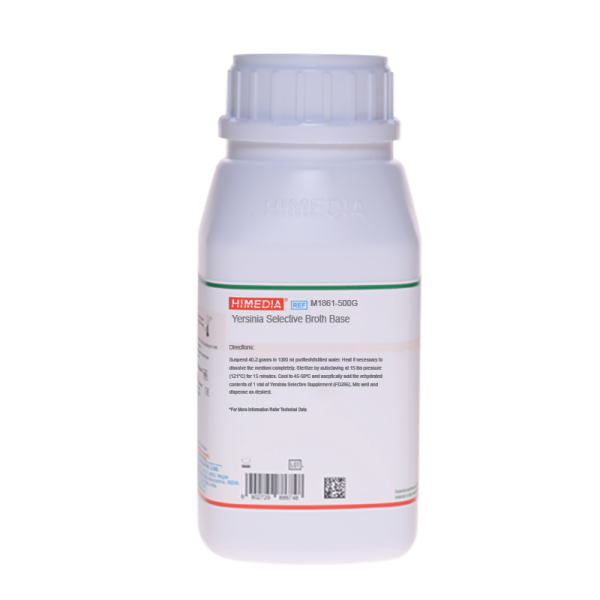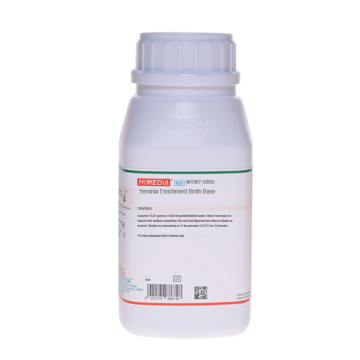 Your enquiry has been submitted
Your enquiry has been submitted
Yersinia Selective Broth Base
Intended use
Recommended for the selective enrichment of Yersinia enterocolitica.
Composition**
| Ingredients | g / L |
|---|---|
| Peptone | 10.000 |
| L-asparaginic acid | 20.000 |
| Sodium pyruvate | 2.500 |
| Tween 80 | 2.200 |
| MOPS/TRIS | 5.500 |
Final pH ( at 25°C): 7.2±0.2
**Formula adjusted, standardized to suit performance parameters
Directions
Suspend 40.2 grams in 1000 ml purified / distilled water. Heat if necessary to dissolve the medium completely. Sterilize by autoclaving at 15 lbs pressure (121°C) for 15 minutes. Cool to 45-50ºC and aseptically add the rehydrated contents of 1 vial of BT Selective Supplement (FD286). Mix well and dispense into sterile tubes or flasks as desired.
Principle And Interpretation
Yersinia enterocolitica is widely distributed in lakes and reservoirs. Epizootic outbreaks of diarrhea, lymphadenopathy, pneumonia and spontaneous abortions occur in various animals. It is the most common species of Yersinia recovered from clinical specimens. Yersinia enterocolitica is biochemically more active at room temperature than at 37°C. Yersinia Selective Broth Base is recommended for the selective enrichment of Yersinia enterocolitica (1).
The medium contains peptone which provides carbonaceous and nitrogenous compounds, long chain amino acids and other essential compounds. L-asparginic acid and sodium pyruvate are growth supporting ingredients. MOPS/TRIS buffers the medium.
Type of specimen
Clinical samples - stool sample; Food and dairy samples
Specimen Collection and Handling
For clinical samples follow appropriate techniques for handling specimens as per established guidelines (2,3).
For food and dairy samples, follow appropriate techniques for sample collection and processing as per guidelines (4,5,6).
After use, contaminated materials must be sterilized by autoclaving before discarding.
Warning and Precautions
In Vitro diagnostic use. For professional use only. Read the label before opening the container. Wear protective gloves/protective clothing/eye protection/ face protection. Follow good microbiological lab practices while handling specimens and culture. Standard precautions as per established guidelines should be followed while handling clinical specimens. Safety guidelines may be referred in individual safety data sheets.
Limitations
- Further serological and Biochemical tests must be carried out on pure colony for complete identification.
Performance and Evaluation
Performance of the medium is expected when used as per the direction on the label within the expiry period when stored at recommended temperature.
Quality Control
Appearance Cream to yellow coloured, homogeneous free flowing powder
Colour and Clarity of prepared medium Yellow coloured clear solution without any precipitate.
Reaction Reaction of 4.02 % w/v aqueous solution at 25ºC . pH : 7.2±0.2
pH 7.00-7.40
Cultural Response
Cultural characteristics observed after an incubation at 25-30°C for 18- 24 hours.
| Organism | Inoculum (CFU) | Growth |
|---|---|---|
| Yersinia enterocolitica ATCC 27729 | 50-100 | good-luxuriant |
| Enterococcus faecalis ATCC 29212 (00087*) | >=104 | inhibited |
| Pseudomonas aeruginosa ATCC 27853 (00025*) | >=104 | inhibited |
Key :(*)- Corresponding WDCM numbers.
Storage and Shelf Life
Store between 10-30°C in a tightly closed container and the prepared medium at 2-8°C. Use before expiry date on the label. On opening, product should be properly stored dry, after tightly capping the bottle in order to prevent lump formation due to the hygroscopic nature of the product. Improper storage of the product may lead to lump formation. Store in dry ventilated area protected from extremes of temperature and sources of ignition Seal the container tightly after use. Product performance is best if used within stated expiry period.
Disposal
User must ensure safe disposal by autoclaving and/or incineration of used or unusable preparations of this product. Follow established laboratory procedures in disposing of infectious materials and material that comes into contact with clinical sample must be decontaminated and disposed of in accordance with current laboratory techniques (2,3).
Reference
- Schiemann D. A., 1979, Can. J. Microbiol., 25: 1298.
- Isenberg, H.D. Clinical Microbiology Procedures Handbook. 2nd Edition.
- Jorgensen, J.H., Pfaller , M.A., Carroll, K.C., Funke, G., Landry, M.L., Richter, S.S and Warnock., D.W. (2015) Manual of Clinical Microbiology, 11th Edition. Vol. 1.
- American Public Health Association, Standard Methods for the Examination of Dairy Products, 1978, 14th Ed., Washington D.C.
- Salfinger Y., and Tortorello M.L., 2015, Compendium of Methods for the Microbiological Examination of Foods, 5th Ed., American Public Health Association, Washington, D.C.
- Wehr H. M. and Frank J. H., 2004, Standard Methods for the Microbiological Examination of Dairy Products, 17th Ed.,APHA Inc., Washington, D.C.
| Product Name | Yersinia Selective Broth Base |
|---|---|
| SKU | M1861 |
| Product Type | Regular |
| Physical Form | Powder |
| Origin | Animal |
| Packaging type | HDPE |
| References | 1. Schiemann D. A., 1979, Can. J. Microbiol., 25: 1298. |
| Customized Product Available | No |







